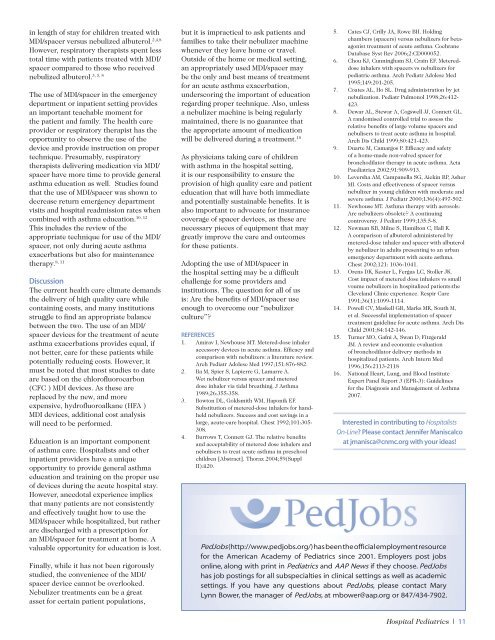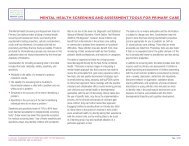Susan Wu, MD, FAAP, Editor - American Academy of Pediatrics
Susan Wu, MD, FAAP, Editor - American Academy of Pediatrics
Susan Wu, MD, FAAP, Editor - American Academy of Pediatrics
Create successful ePaper yourself
Turn your PDF publications into a flip-book with our unique Google optimized e-Paper software.
in length <strong>of</strong> stay for children treated with<br />
<strong>MD</strong>I/spacer versus nebulized albuterol. 2,4,8<br />
However, respiratory therapists spent less<br />
total time with patients treated with <strong>MD</strong>I/<br />
spacer compared to those who received<br />
3, 5, 8<br />
nebulized albuterol.<br />
The use <strong>of</strong> <strong>MD</strong>I/spacer in the emergency<br />
department or inpatient setting provides<br />
an important teachable moment for<br />
the patient and family. The health care<br />
provider or respiratory therapist has the<br />
opportunity to observe the use <strong>of</strong> the<br />
device and provide instruction on proper<br />
technique. Presumably, respiratory<br />
therapists delivering medication via <strong>MD</strong>I/<br />
spacer have more time to provide general<br />
asthma education as well. Studies found<br />
that the use <strong>of</strong> <strong>MD</strong>I/spacer was shown to<br />
decrease return emergency department<br />
visits and hospital readmission rates when<br />
combined with asthma education.<br />
10, 12<br />
This includes the review <strong>of</strong> the<br />
appropriate technique for use <strong>of</strong> the <strong>MD</strong>I/<br />
spacer, not only during acute asthma<br />
exacerbations but also for maintenance<br />
8, 11 therapy.<br />
Discussion<br />
The current health care climate demands<br />
the delivery <strong>of</strong> high quality care while<br />
containing costs, and many institutions<br />
struggle to find an appropriate balance<br />
between the two. The use <strong>of</strong> an <strong>MD</strong>I/<br />
spacer devices for the treatment <strong>of</strong> acute<br />
asthma exacerbations provides equal, if<br />
not better, care for these patients while<br />
potentially reducing costs. However, it<br />
must be noted that most studies to date<br />
are based on the chlor<strong>of</strong>luorocarbon<br />
(CFC ) <strong>MD</strong>I devices. As these are<br />
replaced by the new, and more<br />
expensive, hydr<strong>of</strong>luoroalkane (HFA )<br />
<strong>MD</strong>I devices, additional cost analysis<br />
will need to be performed.<br />
Education is an important component<br />
<strong>of</strong> asthma care. Hospitalists and other<br />
inpatient providers have a unique<br />
opportunity to provide general asthma<br />
education and training on the proper use<br />
<strong>of</strong> devices during the acute hospital stay.<br />
However, anecdotal experience implies<br />
that many patients are not consistently<br />
and effectively taught how to use the<br />
<strong>MD</strong>I/spacer while hospitalized, but rather<br />
are discharged with a prescription for<br />
an <strong>MD</strong>I/spacer for treatment at home. A<br />
valuable opportunity for education is lost.<br />
Finally, while it has not been rigorously<br />
studied, the convenience <strong>of</strong> the <strong>MD</strong>I/<br />
spacer device cannot be overlooked.<br />
Nebulizer treatments can be a great<br />
asset for certain patient populations,<br />
but it is impractical to ask patients and<br />
families to take their nebulizer machine<br />
whenever they leave home or travel.<br />
Outside <strong>of</strong> the home or medical setting,<br />
an appropriately used <strong>MD</strong>I/spacer may<br />
be the only and best means <strong>of</strong> treatment<br />
for an acute asthma exacerbation,<br />
underscoring the important <strong>of</strong> education<br />
regarding proper technique. Also, unless<br />
a nebulizer machine is being regularly<br />
maintained, there is no guarantee that<br />
the appropriate amount <strong>of</strong> medication<br />
will be delivered during a treatment. 10<br />
As physicians taking care <strong>of</strong> children<br />
with asthma in the hospital setting,<br />
it is our responsibility to ensure the<br />
provision <strong>of</strong> high quality care and patient<br />
education that will have both immediate<br />
and potentially sustainable benefits. It is<br />
also important to advocate for insurance<br />
coverage <strong>of</strong> spacer devices, as these are<br />
necessary pieces <strong>of</strong> equipment that may<br />
greatly improve the care and outcomes<br />
for these patients.<br />
Adopting the use <strong>of</strong> <strong>MD</strong>I/spacer in<br />
the hospital setting may be a difficult<br />
challenge for some providers and<br />
institutions. The question for all <strong>of</strong> us<br />
is: Are the benefits <strong>of</strong> <strong>MD</strong>I/spacer use<br />
enough to overcome our “nebulizer<br />
culture”?<br />
REFERENCES<br />
1. Amirav I, Newhouse MT. Metered-dose inhaler<br />
accessory devices in acute asthma. Efficacy and<br />
comparison with nebulizers: a literature review.<br />
Arch Pediatr Adolesc Med 1997;151:876-882.<br />
2. Ba M, Spier S, Lapierre G, Lamarre A.<br />
Wet nebulizer versus spacer and metered<br />
dose inhaler via tidal breathing. J Asthma<br />
1989;26:355-358.<br />
3. Bowton DL, Goldsmith WM, Haponik EF.<br />
Substitution <strong>of</strong> metered-dose inhalers for handheld<br />
nebulizers. Success and cost savings in a<br />
large, acute-care hospital. Chest 1992;101:305-<br />
308.<br />
4. Burrows T, Connett GJ. The relative benefits<br />
and acceptability <strong>of</strong> metered dose inhalers and<br />
nebulisers to treat acute asthma in preschool<br />
children [Abstract]. Thorax 2004;59(Suppl<br />
II):ii20.<br />
5. Cates CJ, Crilly JA, Rowe BH. Holding<br />
chambers (spacers) versus nebulizers for betaagonist<br />
treatment <strong>of</strong> acute asthma. Cochrane<br />
Database Syst Rev 2006;2:CD000052.<br />
6. Chou KJ, Cunningham SJ, Crain EF. Metereddose<br />
inhalers with spacers vs nebulizers for<br />
pediatric asthma. Arch Pediatr Adolesc Med<br />
1995;149:201-205.<br />
7. Coates AL, Ho SL. Drug administration by jet<br />
nebulization. Pediatr Pulmonol 1998;26:412-<br />
423.<br />
8. Dewar AL, Stewar A, Cogswell JJ, Connett GL.<br />
A randomised controlled trial to assess the<br />
relative benefits <strong>of</strong> large volume spacers and<br />
nebulisers to treat acute asthma in hospital.<br />
Arch Dis Child 1999;80:421-423.<br />
9. Duarte M, Camargos P. Efficacy and safety<br />
<strong>of</strong> a home-made non-valved spacer for<br />
bronchodilator therapy in acute asthma. Acta<br />
Paediatrica 2002;91:909-913.<br />
10. Leversha AM, Campanella SG, Aickin RP, Asher<br />
MI. Costs and effectiveness <strong>of</strong> spacer versus<br />
nebulizer in young children with moderate and<br />
severe asthma. J Pediatr 2000;136(4):497-502.<br />
11. Newhouse MT. Asthma therapy with aerosols:<br />
Are nebulizers obsolete? A continuing<br />
controversy. J Pediatr 1999;135:5-8.<br />
12. Newman KB, Milne S, Hamilton C, Hall K.<br />
A comparison <strong>of</strong> albuterol administered by<br />
metered-dose inhaler and spacer with albuterol<br />
by nebulizer in adults presenting to an urban<br />
emergency department with acute asthma.<br />
Chest 2002;121: 1036-1041.<br />
13. Orens DK, Kester L, Fergus LC, Stoller JK.<br />
Cost impact <strong>of</strong> metered dose inhalers vs small<br />
voume nebulizers in hospitalized patients:the<br />
Cleveland Clinic experience. Respir Care<br />
1991;36(1):1099-1114.<br />
14. Powell CV, Maskell GR, Marks MK, South M,<br />
et al. Successful implementation <strong>of</strong> spacer<br />
treatment guideline for acute asthma. Arch Dis<br />
Child 2001;84:142-146.<br />
15. Turner MO, Gafni A, Swan D, Fitzgerald<br />
JM. A review and economic evaluation<br />
<strong>of</strong> bronchodilator delivery methods in<br />
hospitalized patients. Arch Intern Med<br />
1996;156:2113-2118<br />
16. National Heart, Lung, and Blood Institute<br />
Expert Panel Report 3 (EPR-3): Guidelines<br />
for the Diagnosis and Management <strong>of</strong> Asthma<br />
2007.<br />
Interested in contributing to Hospitalists<br />
On-Line? Please contact Jennifer Maniscalco<br />
at jmanisca@cnmc.org with your ideas!<br />
PedJobs (http://www.pedjobs.org/) has been the <strong>of</strong>ficial employment resource<br />
for the <strong>American</strong> <strong>Academy</strong> <strong>of</strong> <strong>Pediatrics</strong> since 2001. Employers post jobs<br />
online, along with print in <strong>Pediatrics</strong> and AAP News if they choose. PedJobs<br />
has job postings for all subspecialties in clinical settings as well as academic<br />
settings. If you have any questions about PedJobs, please contact Mary<br />
Lynn Bower, the manager <strong>of</strong> PedJobs, at mbower@aap.org or 847/434-7902.<br />
Hospital <strong>Pediatrics</strong> | 11



